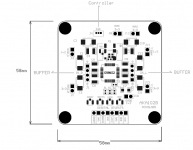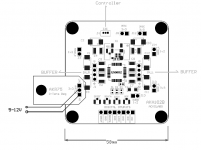Does this mean the final price will go up?There is a fair amount of complexity so decided will be a fully populated board with the desired interfaces and options for a general purpose module to start with.
Does this mean the final price will go up?
Yes, it will but also looking at options for a bare essential model as well in addition to the full featured one previewed earlier - so basically 2 models to choose from
Yes, it will but also looking at options for a bare essential model as well in addition to the full featured one previewed earlier - so basically 2 models to choose from
Basic model:
Requires external 3.3V and 1.2V supplies as shown
Empty board: USD 45
Only IC loaded: USD 85
Fully loaded module: TBA
Availability: TBA
Attachments
Nice - I recognize the layout architecture!
Schema? Teflon? Input for external oscillator (MCK1?)?
//
Schema? Teflon? Input for external oscillator (MCK1?)?
//
Last edited:
It seems in the end I'll be considering the full feature model unassembled with chip preloaded, if there will be at least minor options for HW config via jumpers (bit depth, sampling frequency). Count me in on one if these will be the case 🙂
Nice - I recognize the layout architecture!
Schema? Teflon? Input for external oscillator (MCK1?)?
//
Thanks!
Schema, BOM and support information provided for this basic version (AKA102B). Prices are for FR4 boards only. Teflon/Rogers option ~$120 extra. All options will be listed when design is ready.
On-board XO can be 9x14mm, 7x5mm or 2.5x2mm types. Suits Crystek CCHD957 and NDK XOs. U.FL coax for external clock if preferred
It seems in the end I'll be considering the full feature model unassembled with chip preloaded, if there will be at least minor options for HW config via jumpers (bit depth, sampling frequency). Count me in on one if these will be the case 🙂
Full featured models will be rolled out as fully assembled OEM modules only. Sorry, no options for DIY assembly
Sounds great all around to me. Without a controller, what comes out of the board?
Would be nice with some onboard strapping possibilities.
//
Would be nice with some onboard strapping possibilities.
//
Sounds great all around to me. Without a controller, what comes out of the board?
Would be nice with some onboard strapping possibilities.
//
Without a controller only i2s output, could always send that to a hardware DIT of your choice for SPDIF conversion if that's your preference. I read the datasheet a week or so ago and don't have it in front of me, but I believe that you can configure whether it is master or slave i2s device.
I like the line level input. The ADC card can be reused with many different inputs. Maybe you can design input cards as well?
I would prefer to have on board power regulators (SMPS and very good traditional regulators), since these are difficult to design. Maybe a separate card for this?
The Raspberry Pi can be used to control the ADC through I2C. There is a Python package for reading and writing to I2C.
I would prefer to have on board power regulators (SMPS and very good traditional regulators), since these are difficult to design. Maybe a separate card for this?
The Raspberry Pi can be used to control the ADC through I2C. There is a Python package for reading and writing to I2C.
+1I like the line level input.
+1I would prefer to have on board power regulators (SMPS and very good traditional regulators), since these are difficult to design
ESS Products - ADC
I have tried that maybe a year ago. I even did an NDA, but received nothing. We will need documentation in order to control the ADC. Acko can you talk to ESS so that forum members get access to manuals?
For information about samples or product datasheets, please contact your local ESS Sales Representative.
I have tried that maybe a year ago. I even did an NDA, but received nothing. We will need documentation in order to control the ADC. Acko can you talk to ESS so that forum members get access to manuals?
Sounds great all around to me. Without a controller, what comes out of the board?
Would be nice with some onboard strapping possibilities.
//
ADC is Hi-Res full 32bits in I2S mode and full 24bits in spdif mode.
In hardware mode only I2S is available. Spdif disabled
Sample rates can be selected in hardware mode: 48k, 96k, 192k and 384k (running on a 49.152MHz MCK). If using 45.1584Mhz then 44.1k based Fs possible
No RIAA filters enabled
No mono mode
No multi-channel
Suitable cards can be designed as we go along but the first module needed is a matching buffer to drive the ADC - TBAI like the line level input. The ADC card can be reused with many different inputs. Maybe you can design input cards as well?
There are several well known psu designs already. You can also use 3-term types with connections as shown. Makes it very straightforward and you can experiment with different types rather than a fixed on-board oneI would prefer to have on board power regulators (SMPS and very good traditional regulators), since these are difficult to design. Maybe a separate card for this?
Attachments
Last edited:
AKR47VH Super Regulator 😀
You should also consider battery psu especially if you are shooting for the best when recording or digital mastering
"Sample rates can be selected in hardware mode: 48k, 96k, 192k and 384k"...
How is this done?
//
How is this done?
//
- Status
- Not open for further replies.
- Home
- Source & Line
- Digital Line Level
- ADC using ES9102/9112

